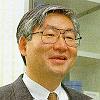- JST Home
- /
- Strategic Basic Research Programs
- /
 ERATO
ERATO- /
- Research Area/Projects/
- Completed/
- OKAYAMA Cell Switching
OKAYAMA Cell Switching

Research Director: Dr. Hiroto Okayama
(Professor, Faculty of Medicine, The University of Tokyo)
Research Term: 1991-1996
The various parts of an organism are formed by cells differentiating into new cells which stably express specialized functions. The cells of higher life forms-yeast, plants and animals-grow and divide in a repeating four-step cycle: growing (G1), copying their genes, growing more (G2) and dividing. G1 growth immediately after division is the most crucial time since a decision is made as to whether the cells proliferate, differentiate or stay quiet. This very basic project utilized a wide array of recently developed tools in order to unravel the secrets of G1 and how to regulate it.
Research Results
Novel G1 regulatory genes found: So far, four novel G1 regulatory genes from fission yeast have been found. Two are called res1 and res2, encode mutually homologous association partners of the Cdc10 protein, and function as key elements for the “start” of the cell cycle. One is a novel factor which controls cell cycle “start” by regulating the function of the Res2-Cdc10 complex. The last is a new B-type cyclin. Quite surprisingly, this cyclin has no G2 function, but positively controls cell cycle “start”, and negatively controls differentiation. In addition, the seventh mammalian cyclin, named cyclin G, as well as a mammalian homologue of budding yeast CDC7 have been identified. These genes provide invaluable clues to our understanding of the “master switch” at the molecular level.
G1 and S-G2 checkpoint mechanisms: Recently, very important clues have been found for understanding the mammalian G1 and fission yeast G2 checkpoint mechanisms. One is that in mammals tyrosine phosphorylation of cdk4 kinase is a key mechanism for the irradiation-responsive G1 checkpoint control. The other is the identification of a key S-phase checkpoint factor sensor of yeast, called cds1, which monitors DNA synthesis by interacting with DNA polymerase alpha and blocks the onset of mitosis.
Long-time conservation of cell-cycle strategy: More than five new factors which are involved in switching, starting or regulating the start of differentiation in a cell have been found. Very interestingly, these factors have been more or less conserved in eukaryote cells throughout time. In this regard a new gene, rcd1, has been found that shows about 70% or even higher conservation from plants through humans.
Similarity between stress and differentiation signals: A new gene has been found that encodes a protein kinase, called Phh1. This kinase mediates some kind of stress signals, such as heat shock or high osmosis stress. It has been found that this type of signal is also essential for cell differentiation. Thus, differentiation of the cell seems to be some kind of response to stress.


·Cell Growth and Differentiation














